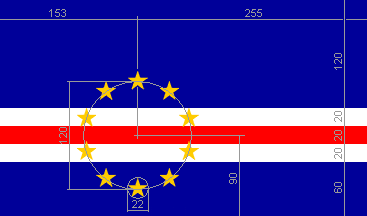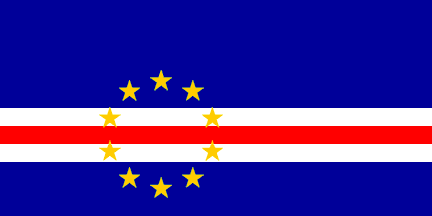António Martins, 30 Nov 2003

Last modified: 2009-09-12 by antónio martins
Keywords: cabo verde | stars: ring | star: 5 points (yellow) | stars: 10 | law | ratio: ambiguous | sea | sky | island | unity | effort | peace | construction | road | compass | helm | world map | horizon |
Links: FOTW homepage |
search |
disclaimer and copyright |
write us |
mirrors

A new flag was adopted on 22 Sep 1992, when Cape Verde finally severed its links with Guinea-Bissau. The new flag has 10 stars representing the islands, set in a blue sea. Prior to 1992, the similarity between the two nations’ flags was explained by the fact that both were derived from the flag of the Partido Africano da Independência da Guiné e Cabo Verde (P.A.I.G.C.), the liberation movement which succeeded in gaining independence for both countries (Guinea-Bissau in 1974, Cape Verde in 1975). P.A.I.G.C.’s aim had been that the two nations should unite, but this merger was scotched in 1980 by a military coup in Guinea-Bissau.C. Veale, quoting [dev94]

The Constitution of the Republic of Cabo Verde (Green Cape Islands),
adopted in 1992, difines under its Article 8th the new flag, very different
from the previous (wich was similar to the
Bissau-Guinea flag, for historical reasons),
and said by some to be very
“unafrican”.
2. The National Flag is made up of five rectangles stacked along its length.
The upper and lower rectangles are blue, being the upper one half of the flag area and the lower one forth.
Separating the two blue rectangles, three stripes each being one 12th of the flag area.
The stripes adjoining the blue rectangles are white and the one between is red.
Over the five rectangles, ten yellow five pointed stars, with the upper apex in the 90 degree position, define a circle which center lies in the intersection of the middle line of the second vertical quarter, counted from the left with the middle line of the second horizontal quarter, counted from the lower edge. The star nearer from this edge is set inside an invisible circle which center lies on the middle line of the lower blue stripe.
Confused? Good — the original is also very “unclear”, to say the least. I’ll try a more clear and concise description:
Over a field of horizontal unequal stripes (from the top: blue, 6 twelveths of the flag’s height; white, 1 twelveth of the flag’s height; red, 1 twelveth of the flag’s height, white, 1 twelveth of the flag’s height; blue, 3 twelveths of the flag’s height), a circle of ten yellow five-pointed stars pointing upwards, with radius of 1/4 of the flag’s height and center 3/8 of the flag’s width from the hoist and 3/8 of the flag’s height from the bottom edge. (Stars’ sizes not specified, neither are the color shades.)
António Martins, 19 May 1997 and 29 Mar 2002

I have a specification by William Crampton,
which refers to a diagram and regulations issued at the time of adoption, and
the copy of a diagram which matches this, but, no actual confirmation that
this is actually the diagram to which he referred, and there was, regrettably,
no copy of the “regulations” as such on file. To make matters even more
uncertain, this gives us a third ratio of 10:17.
Whilst I had (and have) the greatest respect for William’s
professionalism, I have none the less attempted to get some sort of official
confirmation, but (as you would expect) without result.
Christopher Southworth, 20 Jan 2005
As per Crampton’s document Christopher cited: overall ratio
1000:1700, measured along hoist 250+83+83+83+500, along length 638+1062, stars
arranged on a circle of diameter 470 each inscribed in a circle with diameter
91.
Željko Heimer, 29 Jan 2005
The details of the (unfortunately) unconfirmed specification I have are as follows:
On a flag of 1000 × 1700 units, the fly is given as 500-83-83-83-250, the distance to the centre of the imaginary circle which places the stars is given as 638 along the length and 275 up from the base, the diameter of that circle is given as 470, with each star contained within an imaginary circle of diameter equalling 91.
There are two slight problems [later fixed] with this when set against the prescriptions of the Constitution:
Christopher Southworth, 22 Jan 2005
The figure of 638 is from the hoist to the centre point of the imaginary circle around which the stars are arranged, and almost exactly represents the Constitutional requirement of three-eighths the length (the exact figure on a flag of 1700 units long would be 237.5)? The widths given for the various stripes are indeed clumsy (and as I pointed out previously slightly inaccurate), but this could well be due to somebody — and we hope it was somebody official — having measured an actual flag, but they are (in any case) close enough to the legal stipulation of one-twelfth each for the narrow stripes.
A size of 1000 × 1700 units is hardly what I, or an other experienced vexillologist, would choose for a flag whose legal requirements include 3/8, 1/2 and 1/12, but that is what the diagram uses. I must agree that a flag 240 units wide (and if we accept 10:17) 408 units long would be far more sensible, and would give fly measurements of 120-20-20-20-60.
Christopher Southworth, 28 Jan 2005

As per Crampton’s document Christopher
cited the circle of stars is too small in accordance with the
(constitutional) requirement that the lowest
star should be in the middle of the blue stripe. This would be
achieved if the diameter would be 500. (In the image above, figures
reduced to 25/6 to achieve reasonable and yet exact numbers.)
Željko Heimer, 29 Jan 2005
Unless any of the authors above can give a source for those values
(which I doubt, considering their disparity), I believe that they are not
the ratio(s) prescribed by a lesser and more detailed law, but rather
(mis)measurements of real flags, manufactored under the legal license of
no fixed ratio.
António Martins, 24 Jan 2001
The size of the stars is also not mentioned in the
Constitution. As all the images I have seen
show the stars somewhat “entering” the red stripe, they must be
inscribed in circles with diameter larger than exactly 1/12 of the flag’s
height, perhaps 1/10 of the flag’s height.
Željko Heimer, 28 Apr 2001
I just saw on a large photo taken outside the City Hall of São
Filipe (Fogo island) the national flag of Cape Verde. The stars are clearly
Y+, “dark” yellow (![]() ), with clear contrast on the white
areas.
), with clear contrast on the white
areas.
António Martins, 30 Nov 2003
Note that the constitutional discription only refers to
areas and heights and uses independent horizontal and vertical measurements;
that means that no fixed proportions are specified — such a description
could aply to a 1:2, 2:3, 1:1 or most other flag formats!
António Martins, 19 May 1997

This was also the case of the previous flag:
The Constitutions of both Cape Verde and Bissau-Guinea
prescribed «three equal area rectangles, one vertical to the hoist and two
horizontal to the fly», but Cape Verde had a 2:3 flag (each rectangle
being 1×2) and Bissau-Guinea had a 1:2 flag (vertical rectangle 6×4
and horizontal rectangles 3×8).
António Martins, 19 May 1997

On
line photo showing regular flag hoisted upside down — an often
enough sighting, even in official settings, such as this one taken at the 5th
C.P.L.P. confference held in São Tomé e
Príncipe, in 2004.08.02.
António Martins, 15 Jul 2007
A starless flag pattern (but till now I never saw a real flag) is
some times used in several Capeverdean quasi official items, such as
national team uniforms and aircraft
livery. The former colonial master uses a simplified
national flag as its (very “official”) civil and military
aircraft fin flash and rudder mark, which
may (be thought to) exhert some influence.
António Martins, 17 Oct 2007
On these online photos
(#g213,
#g214 and
#g218)
what seems to be a starless variation of the national flag; on these, at the
same location and time
(#g217 and
#g216), we
see that the stars are there…
António Martins, 21 Nov 2006
On line
photo showing a national flag without the ring of stars is shown in use
in a currency exchange rate table in Portugal.
António Martins, 17 Oct 2007
On line image
showing national flag pattern but with the stars in line on the blue area in
sportsmen uniforms, (arguably an "official" item).
António Martins, 15 Jul 2007
.gif)
As on the flag, the stars represent the main islands
of Cape Verde; the plumb-bob is symbolic of rectitude and virtue; the torch
and triangle represent unity and freedom.
Ivan Sache, 21 Jan 2001
Força Aérea Caboverdiana (formed 1982 — 6 cargo
and light planes) and Guarda Costeira de Cabo Verde (with 1 plane);
the book [cos98] reports a
national flag as fin flash (changed as the
flag changed in 1992). See on line photos with
old and
new
markings, and the coast guard’s only plane with the
flag-fin
flash.
Dov Gutterman, 13 Jun 2004
At the official web site, the emblem
of the Civil Defense of Cape Verde, almost identical to the
portuguese one. I could not find any mention
to a flag, though.
António Martins, 14 Jan 2007
Anything below this line was not added by the editor of this page.